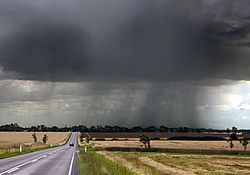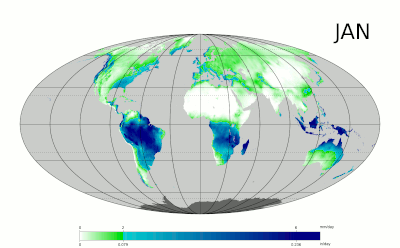Precipitation (meteorology)
In meteorology, precipitation is any form of hydrometeor that falls from the atmosphere and reaches the Earth's surface. This phenomenon includes rain, (thunderstorm) drizzle, snow, sleet, hail, but not virga, mist or dew, which are forms of condensation and not precipitation. The amount of precipitation on a point on the earth's surface is called rainfall, or rainfall amount.
Precipitation is an important part of the hydrological cycle, bringing fresh water to the emerged part of the earth's crust and, therefore, favoring life on our planet, both animals and plants, which require water to live. Precipitation is generated in the clouds, when they reach a saturation point; at this point the water droplets increase in size until they reach a mass in which they fall by the force of gravity. It is possible to seed clouds to induce precipitation by spraying a fine powder or an appropriate chemical (such as silver nitrate) into the cloud, accelerating the formation of raindrops and increasing the probability of precipitation, although these tests have not been satisfactory.
Although rain is the most frequent form of precipitation, the other types should not be forgotten: snowfall and hail. Each of these precipitations can in turn be classified into various types:
The wettest place on the planet is the municipality of Puerto López, in Colombia, with an annual rainfall of 12,892 mm. Other estimates suggest that Lloró and López de Micay in Colombia had a rainfall of 13,473 mm.
Precipitation measurement
Precipitation values, to be valid, must be scientifically comparable.
Precipitation is important for the rain gauge and the rain gauges, the latter are used to determine the rainfall of short duration and high intensity. These instruments must be installed in appropriate locations where there is no interference from buildings, trees, or orographic elements such as elevated rocks.
Pluvial precipitation is measured in mm, which would be the thickness of the sheet of water that would form, due to precipitation, on a flat and impermeable surface and which is equivalent to liters of water per square meter of land (l /m²).
Since 1960, the measurement of rain by means of meteorological radar has become increasingly popular, which is generally directly connected to mathematical models that allow determining the intensity of rain in an area and the flows in real time, in a certain section of a river in that area.
Source of precipitation
In essence, all precipitation of water in the atmosphere, whatever its state (solid or liquid) is produced by the condensation of the water vapor contained in the air masses, which originates when said air masses are forced to rise and cool. For condensation to occur, the air must be saturated with moisture and there must be nuclei of condensation.
Air is saturated if it contains as much water vapor as possible. Its relative humidity is then 100 percent. The saturation state is normally reached by cooling the air, since cold air is saturated with less water vapor than warm air. Thus, for example, 1 m³ of air at a temperature of 25 °C, whose water vapor content is 11 g, is not saturated; but the 11 g saturates it at 10 °C, and then condensation is already possible.
The condensation nuclei (which allow the water vapor to recover its liquid state) are tiny particles suspended in the air: particles that come from the smoke or from microscopic salt crystals that accompany the evaporation of sea mists. This is how clouds are formed. The smallness of the drops and crystals allows them to remain suspended in the air and be moved by the winds. You can count 500 per cm³ and yet 1 m³ of cloud contains barely three grams of water.
Clouds become rain when the droplets get thicker and heavier. The phenomenon is very complex: differences in electric charge allow the droplets to attract each other; the "nuclei," which are often tiny ice crystals, facilitate condensation. This is how electrical discharges are accompanied by violent precipitation. The "artificial rain" technique consists of "seeding" the vertex of the clouds, when there is a temperature below 0 °C, with sodium iodide; this is divided into tiny particles, which cause the freezing of water; these ice crystals turn into rain when they enter air whose temperature is above 0 °C.
Temporal variation of precipitation
Precipitations vary according to certain temporal cycles determined by terrestrial rotation and translation movements and by the astronomical or geographical location of the place in question. These cycles can be: daily, monthly or seasonal or in annual cycles, in fact, there are always months in which rainfall is greater than in others. For example, in San Francisco, California (United States), the months with the highest rainfall occur between November and March, while in Miami, Florida the months with the highest rainfall are from May to October.
In order to correctly assess the objective characteristics of the climate, in which precipitation, and especially rain, plays a very important role, the monthly precipitations must have been observed for a period of at least 20 to 30 years, what is called a long observation period.
The seasonal variation of precipitation, especially of rain, defines the hydrological year. This begins in the month following the month with the lowest average long-term rainfall. For example, in San Francisco, the hydrological year begins in August, while in Miami it begins in January.
Spatial variation of precipitation
The spatial distribution of precipitation on the continents is very varied, thus there are extensive areas such as deserts, where precipitation is extremely low, in the order of 0 to 200 mm of precipitation per year. In the Sahara desert, the average annual rainfall is barely a few mm, while in the areas close to the Gulf of Darién between Colombia and Panama, the annual rainfall is over 3,000 mm, with a maximum of about 10 meters (10,000 mm).). The Atacama desert in northern Chile is the driest area of all the continents.
The orography strongly influences rainfall. An elevation of the terrain very frequently causes a local increase in precipitation, by causing the ascension of air masses saturated with water vapor (orographic rains).
Precipitation height
To carry out measurements, the height of the rainwater that would cover the ground surface would be verified, in the area of influence of a pluviometric station, if it could be maintained on it without filtering or evaporating. It is usually expressed in
Precipitation is measured by means of rain gauges or pluviographs, the seconds are mainly used when it comes to determining short-term intense rainfall. In order for the values to be comparable, in the pluviometric stations, standardized instruments are used.
Importance of precipitation in engineering
In agricultural engineering it is influenced by climatic factors in the irrigation and drainage of crops and the use of water in certain areas depending on precipitation as well as land conservation. Many civil engineering works are deeply influenced by climatic factors, due to its importance, rainfall stands out. Indeed, a correct dimensioning of the drainage will guarantee the useful life of a highway, a railway, an airport. The knowledge of extreme rainfall and consequently the proper dimensioning of hydraulic works, such as spillways of exceedances of dams, will guarantee their proper functioning and the safety of the populations located downstream. The calculation of extreme rains, of short duration, is very important to size urban drainage, and thus evacuate volumes of water that could cause flooding.
The characteristics of the pluvial precipitations that must be known for these cases are:
Intensity of rain and duration of rain: these two characteristics are associated. For the same return period, as the duration of the rain increases, its average intensity decreases. The formulation of this dependency is empirical and is determined on a case-by-case basis, based on data directly observed at the study site or at other nearby sites. with similar hydrometeorological characteristics. Such formulation is known as Intensity-Duration-Frequency relationship or commonly known as IDF curves.
The extreme rainfall return periods of 2, 5, 10, 20, 50, 100, 500, 1000 and up to 10,000 years, for each particular site or for a basin, or the probable maximum precipitation, or PMP, are determined with statistical procedures, based on extensive rainfall records.
Determination of average rainfall in a basin
The dimensions of a hydrographic basin are very varied and the precipitations also vary in time and space. In order to take these diversities into account and to know the behavior of the rains, as well as their magnitude in such conditions, several pluviometric stations are frequently installed in the same.
To determine the average rainfall in the basin, a specific return period is chosen, the rainfall in each station for the selected return period is determined and then the average rainfall is calculated, for this one of the following procedures is used: Thiessen polygons and the isohyet method.
It is common to find regions with no records or with little information, so regional evaluation criteria must be used. The regionalization hypothesis is that the important rains occurred in nearby sites, which generates the advantage of taking advantage of the data from the stations where those events were recorded.
Contenido relacionado
Jose Comas y Solá
Monomer
Guanine





